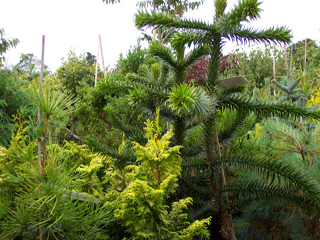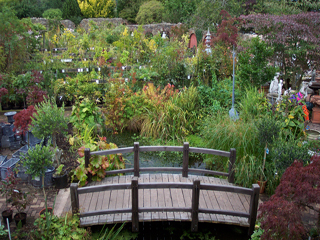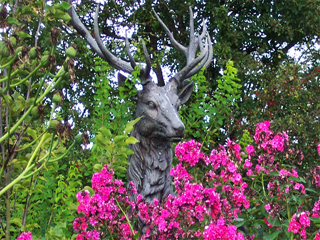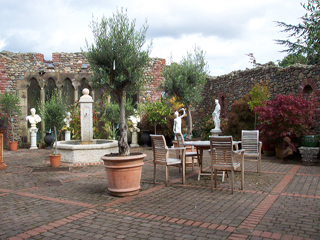Visited on September 18, 2007
Larch Cottage Nursery was labeled as “A Shoppers Paradise,” “Wildly different,” unique with one of the most comprehensive collection of rare plants in the country, on the internet site that my daughter had sent me for vacation planning in Cumbria. A local newspaper wrote that it was “The Lake District’s best kept horticulture secret.” The gardeners at Holehird Gardens strongly recommended that we visit Larch Cottage, owned and operated by Peter Stott. Apparently, the secret was out.

David and I took the train from Manchester to Penrith, the historic red-sandstone town referred to as the “Gateway to the Northern Lakes.” Directly across from the train station was the ruins of a 14th century royal fortress. It had served as a frontline defense from Scotland and as a home to Richard, Duke of Gloucester before his title as Richard the III. The predominately surrounding farmland called Eden Valley is above the Northern Lake District and beside the north Pennine mountains. Larch Cottage is located in the small hamlet of Melkinthorpe, 4 miles south of Penrith.

A courtyard in brick, a Roman stone maiden at the entrance with heavy oak doors, above a clock tower with stained glass windows; rough-hewn Italian-styled stone-walls that continued around the perimeter of the nursery, Larch Cottage would become an unexpected break from the traditional garden centres we had been visiting on this trip.
Larch Cottage is a nursery evolved from Peter Stott’s hard physical labor (when he purchased the property the row houses and ground were in derelict condition), his interest in the arts, (the study of dance in London), and an aptitude in landscaping and garden design. He learned the craft of masonry, stained glass window cutting and assembling, which he used in the creation of this nursery. He has integrated his landscaping skills in hardscaping with artistic expression, focusing on predominately Romanesque themes.

Opening his nursery in 1985, the intention was to supple his landscaping business with plants, especially unusual plants that he wanted to use in his landscape designs but was not able to obtain. He created an unusual niche in the marketing world of horticulture by specializing in the unusual and old fashion perennials and roses, rare and dwarf conifers, Japanese Maples, climbers, alpine and rock garden plants. The Araucaria araucana, or as it is nicknamed, the Monkey Puzzle Tree, is an example of an unusual conifer that he grows that would not be found at a commercial garden centre. Ornamental and hardy fruit trees are also available. His interest in woody plants is obvious by the large collection he has available.
He grows many of the plants in poly tunnels off premises, which gives him a unique spot in a competitive business. His stock is hardy, acclimated to the northern weather and will tolerate most areas of the British Isles. The nursery can provide over 15,000 varieties of plants, many rare and unusual. From our conversations we had with other customers there, it was our impression that he has a base of serious gardeners that are loyal customers.

The brick patterned walkway that led from the entrance guided us to a wooden bridge over the aquatic pond which provided a visual display of the greens, yellow and reds of early fall foliage throughout the nursery. Hardy native aquatic plants, many suitable for small ponds were used. Veronica beccabunga (brookline speedwell), Potentilla palustris (marsh cinquefoil), Cyperus longus (cypress root) and Typha minima, a bulrush were examples of the plants that can survive wet and boggy grounds in the northern Cumbria winters.

The theme of the nursery is quickly recognized by the large collection of stoneware near the entryway; exquisite statues of men and women in the Greco-Roman style, the urns imported from Italy and stoneware of gremlins, gargoyles and cupids. Buddha of various shapes and sizes for the meditative garden, hard- carved items from Asia and distinctive bird baths with pedestals were in this collection. Besides stone, garden statuary was found throughout the nursery in marble, bronze and lead. A selection of beautiful terracotta and glazed pots with artistic designs and patterns were available for indoor and outdoor use.

The layout of the nursery was designed to lead the customer through the landscape to achieve both efficiency and esthetic objectives. For example, the plant benches were laid out in traditional rows for easier maintenance and customer shopping. Established in ground plantings surrounded the perimeter of the benches and gave an impressive example of what a good gardener could display in their own landscaping. My favorite perennial in bloom at the time was the Centaurae montana ‘Parham’ (perennial cornflower). Another choice perennial in healthy bloom was Acanthus mollis (Bear’s Breeches) as well as Rosa alba, the wedding day rose which is suited for northern climates.

The nursery itself is a theatrical display. Peter Stott’s interest in the theatre is shown in the display and placement of his unusual plants, original sculpture and garden related merchandise. Large sculptures were placed throughout the nursery among the plant displays, and on the brick walls surrounding the perimeter of the nursery. My favorite was the Stag placed within a tangle of late season blooms of phlox.

The artist vision takes us through a stroll through Antiquity where rough-hewed Italian stonewalls serve as a backdrop to the nursery plants. The winding paths and strategically placed open arches in the walls provide new vistas at each turn presenting something different and unexpected, constantly changing the appearance of the nursery.

Brick herringbone patterns on the walkways showed the detailed touch of an artistic landscaper. In other areas, the use of slate laid in diamond patterns added to the richness of the plants displayed along the walkways. Combination stone and brick walls with arched openings formed a theme, moving you forward. One of the paths ended with a stone- wall, encased with three stained glass windows with vivid colored designs of a tree in each opening.

Each time you walk through an arch you are presented with something different and unexpected. As if leading you by the hand, the paths and doorways move you from one garden display to another, each with its own theme and place in time. Zeus, (or to the Romans Jupiter) god of justice and heaven holds court overlooking in-ground garden plantings and nursery benches. Another archway leads to a Japanese dry stone garden with a meditative Buddha tucked among hostas.

The artist’s imagination opens the doorway into past a life with a Roman centurion and lion at the end of a walkway. As you exit another world opens. Pan, the god of creativity and music plays on his pan pipes. Italian tenor arias float through the sunshine, transporting the psyche into an altered consciousness.

Leaving behind the gods and goddesses of mythology that inhabited Larch Cottage we took a visit next door to Peter Stott’s and Jean Wood’s Red Barn Art Gallery. The18th century barn and stable was converted into a two- story gallery to showcase the work of contemporary artist from Britain and Europe. Walking through the gallery we found paintings, sculptural pieces, glass, ceramics and jewelry for sale.

You cannot leave Larch Cottage without a meal from their restaurant. The food is fresh from their garden or local, prepared daily. The organic kitchen garden at the nursery provides fresh herbs and vegetables, soft fruits and blueberries for the restaurant. The Italian vegetable seed Franchi is used with great success in their garden.
The fine workmanship, from the stained glass on the entrance doors, tiled floors, brick and wooden beams as well as fresh flowers on the table and Peruvian music, provided an environment conducive to pleasurable dining. There is outside seating on a Spanish style veranda where an overlook of the pond and the gardens can be enjoyed with a view of the Pennines in the distance. Since we have had the benefit of eating fresh food from our own organic vegetable garden and fruit trees, the restaurant fare was a much appreciated. The Greenhouse Restaurant provided my favorite meal of the tour.

Larch Cottage was David’s favorite gardening destination on our trip. David has been a performing artist (singing and acting) and quickly recognized Peter Stott as a person whose artistic sensibilities and vision puts him in a class by himself. Also, having been a craftsman in the building business, he appreciated the detailed craftsmanship in the creation of this nursery.

After reflecting on our visit, I am of the impression that he has translated some of the theatre and art scene of London to this rural Cumbria area in the presentation of his landscaped gardens and the Red Barn Gallery. What sets Larch Cottage apart from retail businesses selling plants and/or landscape products are the two passions of art and horticulture combined into a living that goes beyond profit motive. His artistic temperament shows thru as the guiding force of his business. Detailed craftsmanship, a love of art and Italy makes Larch Cottage a unique garden nursery in the United Kingdom.
Additional photos of Larch Cottage can be found in the Photo Archive (see the left sidebar).
Visit this site at: www.larchcottage.co.uk/